A Sensing-Based Visualization Method for Representing Pressure Distribution in a Multi-Zone Building by Floor
Abstract
:1. Introduction
2. Methodology
- Based on the building floor plan, the numbers of columns along two sides of the target building are first identified. (In the target building shown in Figure 1, there are eight columns and six columns along the two directions).
- T building floor plan can first be divided into groups of small rectangles based on the locations of the columns. (The numbers of rectangles for the target floor in Figure 1 are 30 inside the boundary of the building and 40 outside).
- The number of measurement zones is identified, and the maximum number of zones between two adjacent columns is selected. (There are nine measurement zones for the target floor, and the maximum number of zones between any two columns is set to two).
- Following the preliminary grid layout and the maximum number of zones between two adjacent columns, the final grid of the building floor plan is obtained. (The total numbers of grid squares for the target building floor in Figure 1 are 105 inside the boundary of the building and 147 outside).
- A Cartesian coordinate system is established, with the X-axis and Y-axis oriented along the two selected sides of the target building. The location of each grid square derived in Step I is expressed as a single coordinate point.
- The measurement zones are represented by various groups of coordinates (x, y).
- The coordinate system of measurement zones can be obtained for each floor through the same procedures.
- The coordinates of the measurement zones are organized by floor.
- Spatial and numerical mapping relationships (x, y, z) are determined using the collection of coordinates and the monitored pressure values of each zone.
- Based on the spatial and numerical mapping relationships of the measurement zones, the pressure distribution mappings are drawn using the three-dimensional plotting tool in MATLAB.
3. Development of the Pressure-Sensing System for Pressure Monitoring
4. Pressure Mappings for Target Buildings Based on the Proposed Visualization Method
4.1. Description of the Target Building
4.2. Pressure Variation during Measurement Periods
4.3. Pressure Mappings of the Target Buildings
4.3.1. Grid Formation for the Floor Plan of the Target Buildings
4.3.2. Establishment of Coordinate Systems for the Measurement Zones
4.3.3. Determination of Spatial and Numerical Mapping Relationship
4.3.4. Pressure Mapping for the Target Buildings
5. Discussion
6. Conclusions
Author Contributions
Funding
Institutional Review Board Statement
Informed Consent Statement
Data Availability Statement
Conflicts of Interest
References
- Guo, M.; Xu, P.; Xiao, T.; He, R.; Dai, M.; Miller, S.L. Review and Comparison of HVAC Operation Guidelines in Different Countries during the COVID-19 Pandemic. Build. Environ. 2021, 187, 107368. [Google Scholar] [CrossRef] [PubMed]
- Mckeen, P.; Liao, Z. The Influence of Airtightness on Contaminant Spread in MURBs in Cold Climates. Build. Simul. 2022, 15, 249–264. [Google Scholar] [CrossRef] [PubMed]
- Park, S.; Cai, Y.; Lim, H.; Song, D. Analysis of Vertical Movement of Particulate Matter Due to the Stack Effect in High-Rise Buildings. Atmos. Environ. 2022, 279, 119113. [Google Scholar] [CrossRef]
- Kreiger, B.K.; Srubar, W.V. Moisture Buffering in Buildings: A Review of Experimental and Numerical Methods. Energy Build. 2019, 202, 109394. [Google Scholar] [CrossRef]
- Kim, J.; Brandemuehl, M.J. Application Method of a Simplified Heat and Moisture Transfer Model of Building Construction in Residential Buildings. Energies 2021, 14, 4180. [Google Scholar] [CrossRef]
- Ji, Y.; Duanmu, L.; Liu, Y.; Dong, H. Air Infiltration Rate of Typical Zones of Public Buildings under Natural Conditions. Sustain. Cities Soc. 2020, 61, 102290. [Google Scholar] [CrossRef]
- Feijó-Muñoz, J.; Pardal, C.; Echarri, V.; Fernández-Agüera, J.; Assiego de Larriva, R.; Montesdeoca Calderín, M.; Poza-Casado, I.; Padilla-Marcos, M.Á.; Meiss, A. Energy Impact of the Air Infiltration in Residential Buildings in the Mediterranean Area of Spain and the Canary Islands. Energy Build. 2019, 188–189, 226–238. [Google Scholar] [CrossRef]
- Tamblyn, R.T. Coping with Air Pressure Problems in Tall Buildings. ASHRAE Trans. 1991, 824–827. [Google Scholar]
- Lee, D.S.; Ji, K.H.; Jing, J.; Jo, J.H. Experimental Study on Elevator Door Reopening Problems Caused by Stack Induced Pressure Differences across the Elevator Door in Buildings. Build. Environ. 2022, 221, 109271. [Google Scholar] [CrossRef]
- Parkinson, T.; Parkinson, A.; de Dear, R. Continuous IEQ Monitoring System: Context and Development. Build. Environ. 2019, 149, 15–25. [Google Scholar] [CrossRef]
- Jo, J.; Jo, B.; Kim, J.; Kim, S.; Han, W. Development of an IoT-Based Indoor Air Quality Monitoring Platform. J. Sens. 2020, 2020, 8749764. [Google Scholar] [CrossRef]
- Perez, A.O.; Bierer, B.; Scholz, L.; Wöllenstein, J.; Palzer, S. A Wireless Gas Sensor Network to Monitor Indoor Environmental Quality in Schools. Sensors 2018, 18, 4345. [Google Scholar] [CrossRef] [PubMed]
- Sung, W.T.; Hsiao, S.J.; Shih, J.A. Construction of Indoor Thermal Comfort Environmental Monitoring System Based on the IoT Architecture. J. Sens. 2019, 2019, 2639787. [Google Scholar] [CrossRef]
- Landaluce, H.; Arjona, L.; Perallos, A.; Falcone, F.; Angulo, I.; Muralter, F. A Review of Iot Sensing Applications and Challenges Using RFID and Wireless Sensor Networks. Sensors 2020, 20, 2495. [Google Scholar] [CrossRef] [PubMed]
- Turley, C.; Jacoby, M.; Pavlak, G.; Henze, G. Development and Evaluation of Occupancy-Aware HVAC Control for Residential Building Energy Efficiency and Occupant Comfort. Energies 2020, 13, 5396. [Google Scholar] [CrossRef]
- Szagri, D.; Dobszay, B.; Nagy, B.; Szalay, Z. Wireless Temperature, Relative Humidity and Occupancy Monitoring System for Investigating Overheating in Buildings. Sensors 2022, 22, 8638. [Google Scholar] [CrossRef]
- Zhou, P.; Huang, G.; Li, Z. Demand-Based Temperature Control of Large-Scale Rooms Aided by Wireless Sensor Network: Energy Saving Potential Analysis. Energy Build. 2014, 68, 532–540. [Google Scholar] [CrossRef]
- Zhang, D.; Mui, K.W.; Wong, L.T. Ten Questions Concerning Indoor Environmental Quality (IEQ) Models: The Development and Applications. Appl. Sci. 2023, 13, 3343. [Google Scholar] [CrossRef]
- Quesada-Molina, F.; Astudillo-Cordero, S. Indoor Environmental Quality Assessment Model (IEQ) for Houses. Sustainability 2023, 15, 1276. [Google Scholar] [CrossRef]
- Yang, L.; Yan, H.; Lam, J.C. Thermal Comfort and Building Energy Consumption Implications—A Review. Appl. Energy 2014, 115, 164–173. [Google Scholar] [CrossRef]
- Aguilar, A.J.; de la Hoz-Torres, M.L.; Ruiz, D.P.; Martínez-Aires, M.D. Monitoring and Assessment of Indoor Environmental Conditions in Educational Building Using Building Information Modelling Methodology. Int. J. Environ. Res. Public Health 2022, 19, 13756. [Google Scholar] [CrossRef]
- Chen, C.; Zhao, B. Review of Relationship between Indoor and Outdoor Particles: I/O Ratio, Infiltration Factor and Penetration Factor. Atmos. Environ. 2011, 45, 275–288. [Google Scholar] [CrossRef]
- Fan, M.; Fu, Z.; Wang, J.; Wang, Z.; Suo, H.; Kong, X.; Li, H. A Review of Different Ventilation Modes on Thermal Comfort, Air Quality and Virus Spread Control. Build. Environ. 2022, 212, 108831. [Google Scholar] [CrossRef]
- Mohammadi, M.; Calautit, J. Quantifying the Transmission of Outdoor Pollutants into the Indoor Environment and Vice Versa—Review of Influencing Factors, Methods, Challenges and Future Direction. Sustainability 2022, 14, 10880. [Google Scholar] [CrossRef]
- Arens, E.; Ghahramani, A.; Przybyla, R.; Andersen, M.; Min, S.; Peffer, T.; Raftery, P.; Zhu, M.; Luu, V.; Zhang, H. Measuring 3D Indoor Air Velocity via an Inexpensive Low-Power Ultrasonic Anemometer. Energy Build. 2020, 211, 109805. [Google Scholar] [CrossRef]
- Protopsaltis, A.; Sarigiannidis, P.; Dimitrios Margounakis, A.L. Data Visualization in Internet of Things: Tools, Methodologies, and Challenges. In Proceedings of the 15th International Conference on Availability, Reliability, and Security, Dublin, Ireland, 25–28 August 2020; pp. 1–11. [Google Scholar]
- Shin, M.; Lee, S.I.; Lee, H.; Lee, J.K. Sensing the Room: An Integrated Implementation Process to Visualize Indoor Temperature Data on Floor Plans. Vis. Eng. 2014, 2, 57. [Google Scholar] [CrossRef]
- Niedrite, L.; Arnicans, G.; Solodovnikova, D. Visualization of Indoor Sensor Data to Reduce the Risk of COVID-19 Infection. CEUR Workshop Proc. 2022, 3158, 101–112. [Google Scholar]
- Lu, W.; Ai, T.; Zhang, X.; He, Y. An Interactive Web Mapping Visualization of Urban Air Quality Monitoring Data of China. Atmosphere 2017, 8, 148. [Google Scholar] [CrossRef]
- Encalada-Malca, A.A.; Cochachi-Bustamante, J.D.; Rodrigues, P.C.; Salas, R.; López-Gonzales, J.L. A Spatio-Temporal Visualization Approach of PM10 Concentration Data in Metropolitan Lima. Atmosphere 2021, 12, 609. [Google Scholar] [CrossRef]
- Schneider, P.; Castell, N.; Vogt, M.; Dauge, F.R.; Lahoz, W.A.; Bartonova, A. Mapping Urban Air Quality in near Real-Time Using Observations from Low-Cost Sensors and Model Information. Environ. Int. 2017, 106, 234–247. [Google Scholar] [CrossRef]
- Li, J.; Li, H.; Ma, Y.; Wang, Y.; Abokifa, A.A.; Lu, C.; Biswas, P. Spatiotemporal Distribution of Indoor Particulate Matter Concentration with a Low-Cost Sensor Network. Build. Environ. 2018, 127, 138–147. [Google Scholar] [CrossRef]
- Choi, H.; Kim, H.; Yeom, S.; Hong, T.; Jeong, K.; Lee, J. An Indoor Environmental Quality Distribution Map Based on Spatial Interpolation Methods. Build. Environ. 2022, 213, 108880. [Google Scholar] [CrossRef]
- Yu, Z.; Song, Y.; Song, D.; Liu, Y. Spatial Interpolation-Based Analysis Method Targeting Visualization of the Indoor Thermal Environment. Build. Environ. 2021, 188, 107484. [Google Scholar] [CrossRef]
- Martínez-Comesaña, M.; Ogando-Martínez, A.; Troncoso-Pastoriza, F.; López-Gómez, J.; Febrero-Garrido, L.; Granada-Álvarez, E. Use of Optimised MLP Neural Networks for Spatiotemporal Estimation of Indoor Environmental Conditions of Existing Buildings. Build. Environ. 2021, 205, 108243. [Google Scholar] [CrossRef]

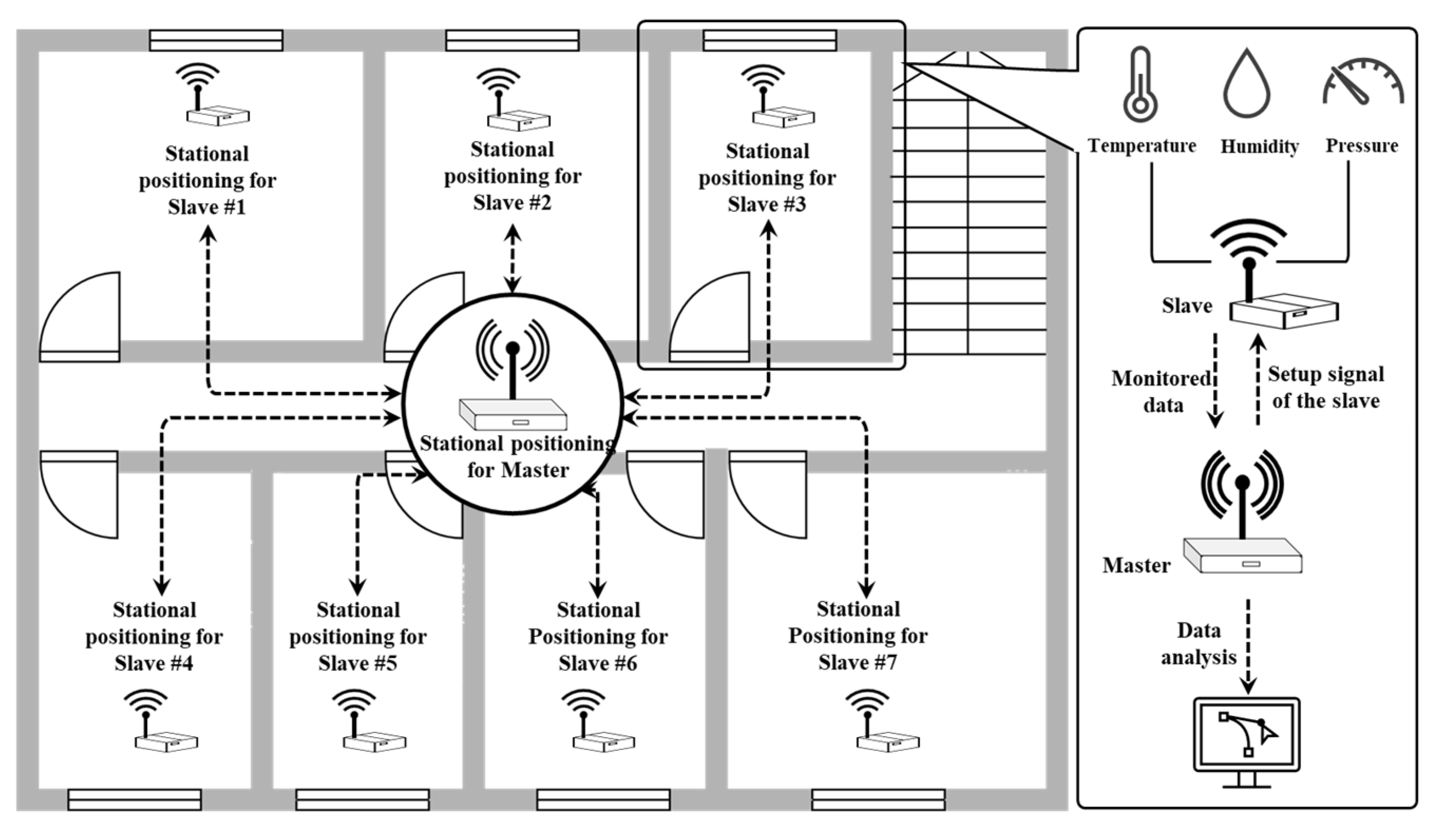

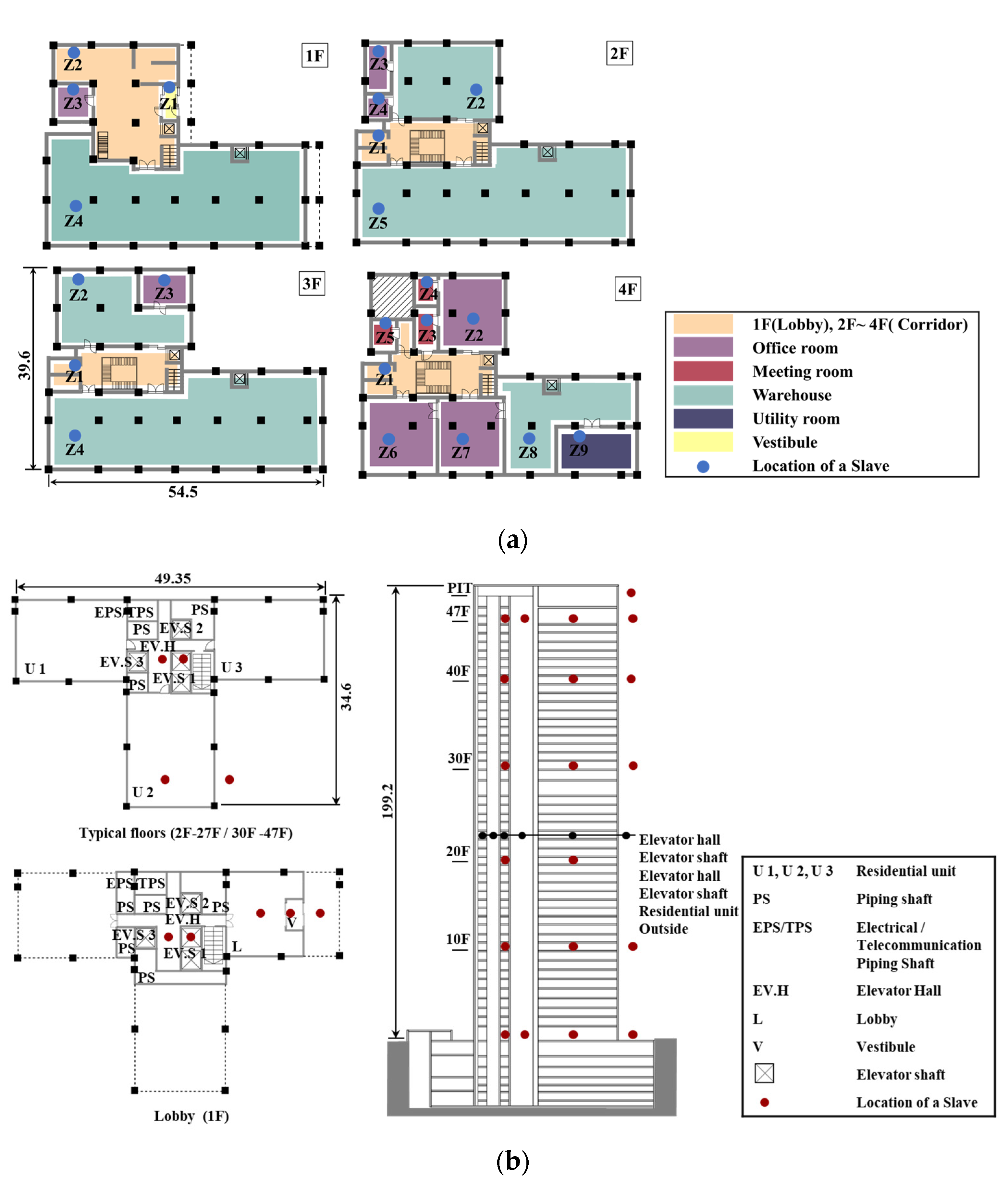


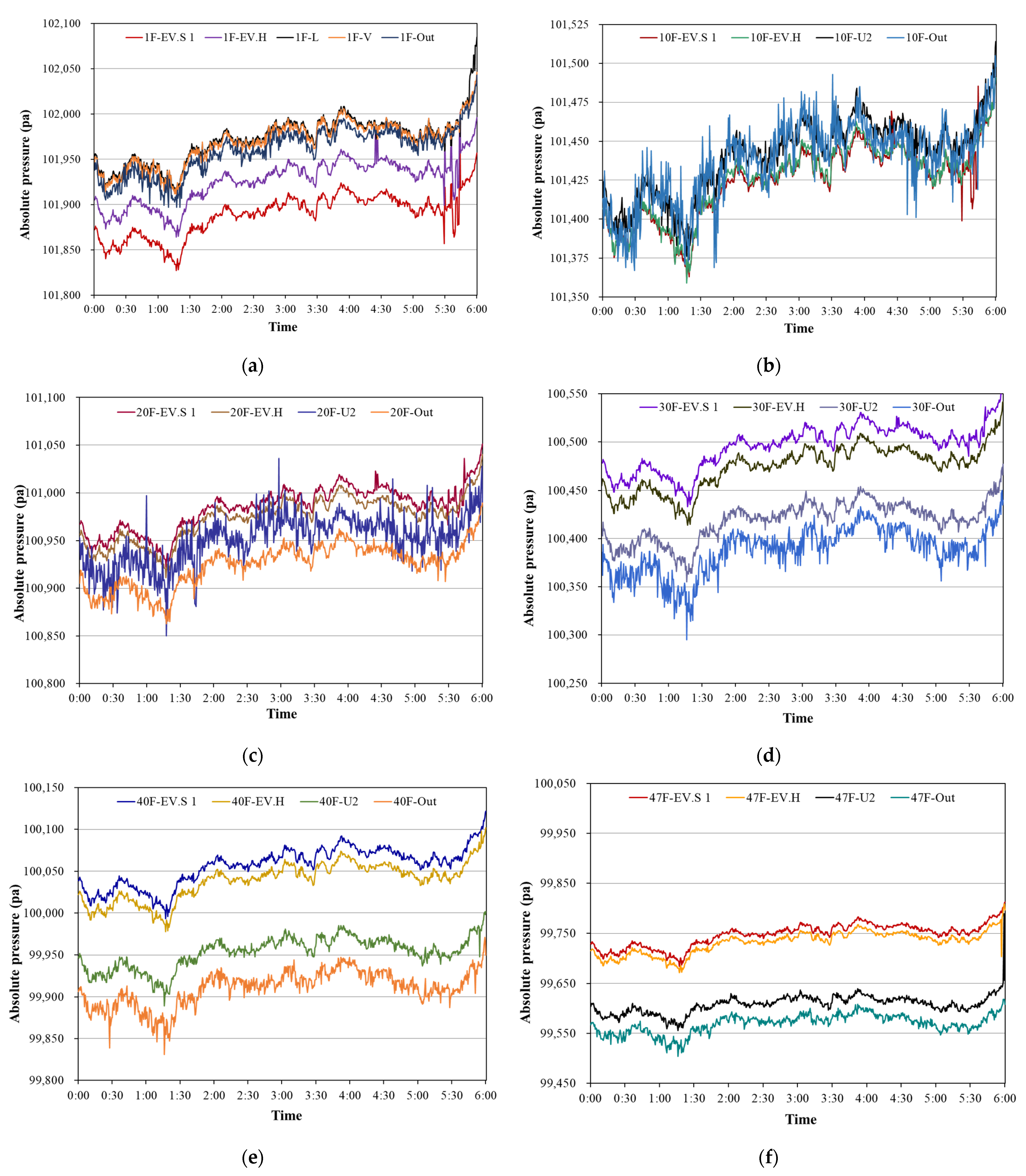

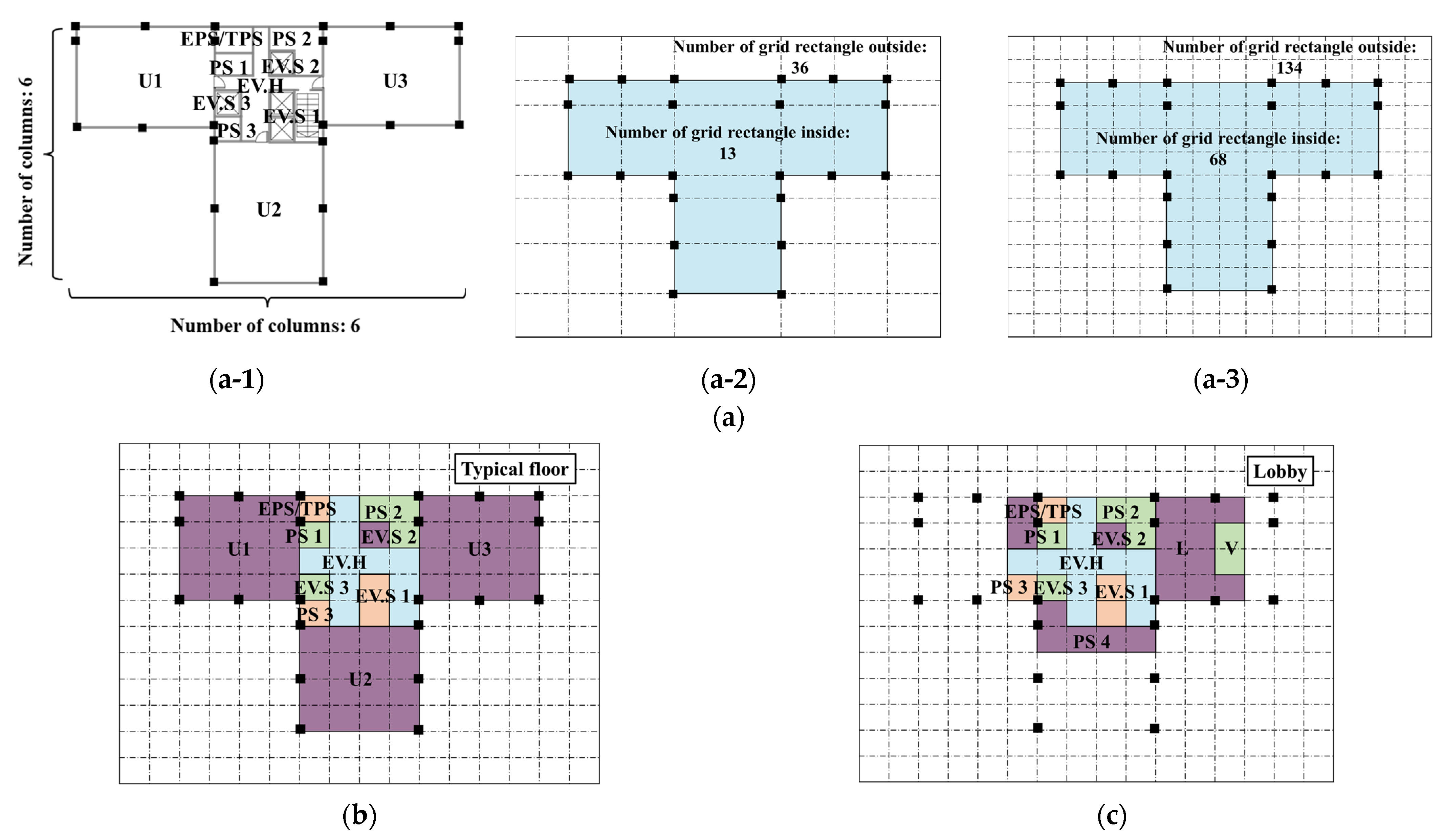
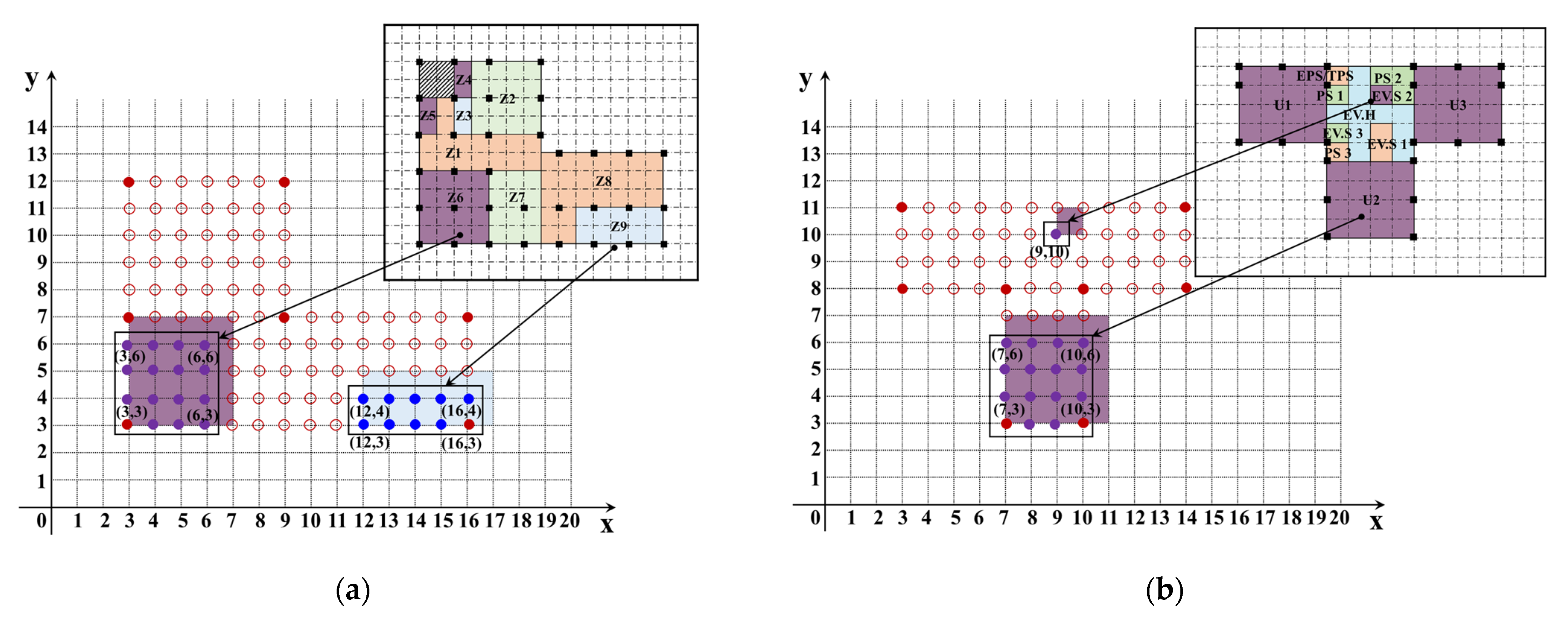
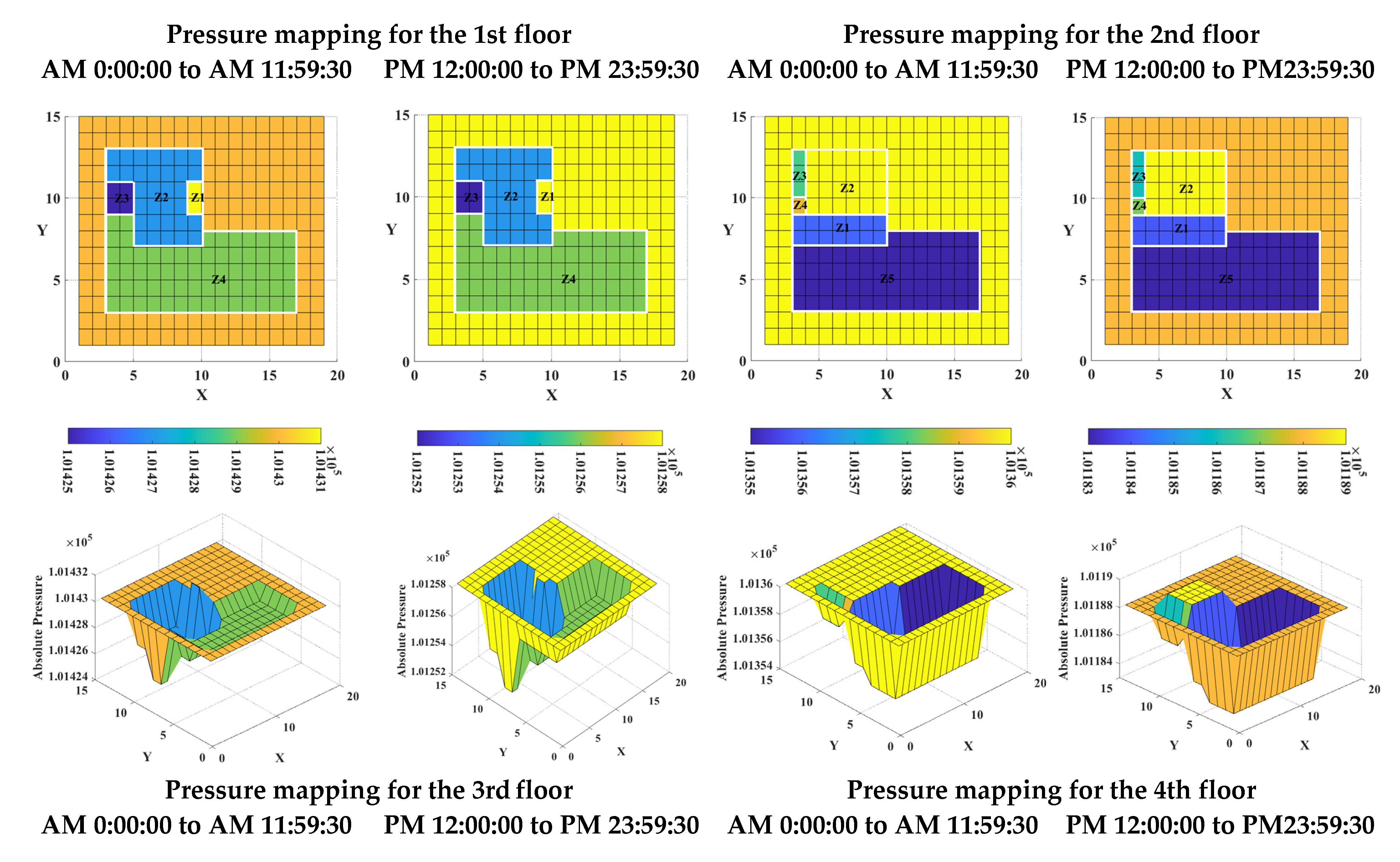
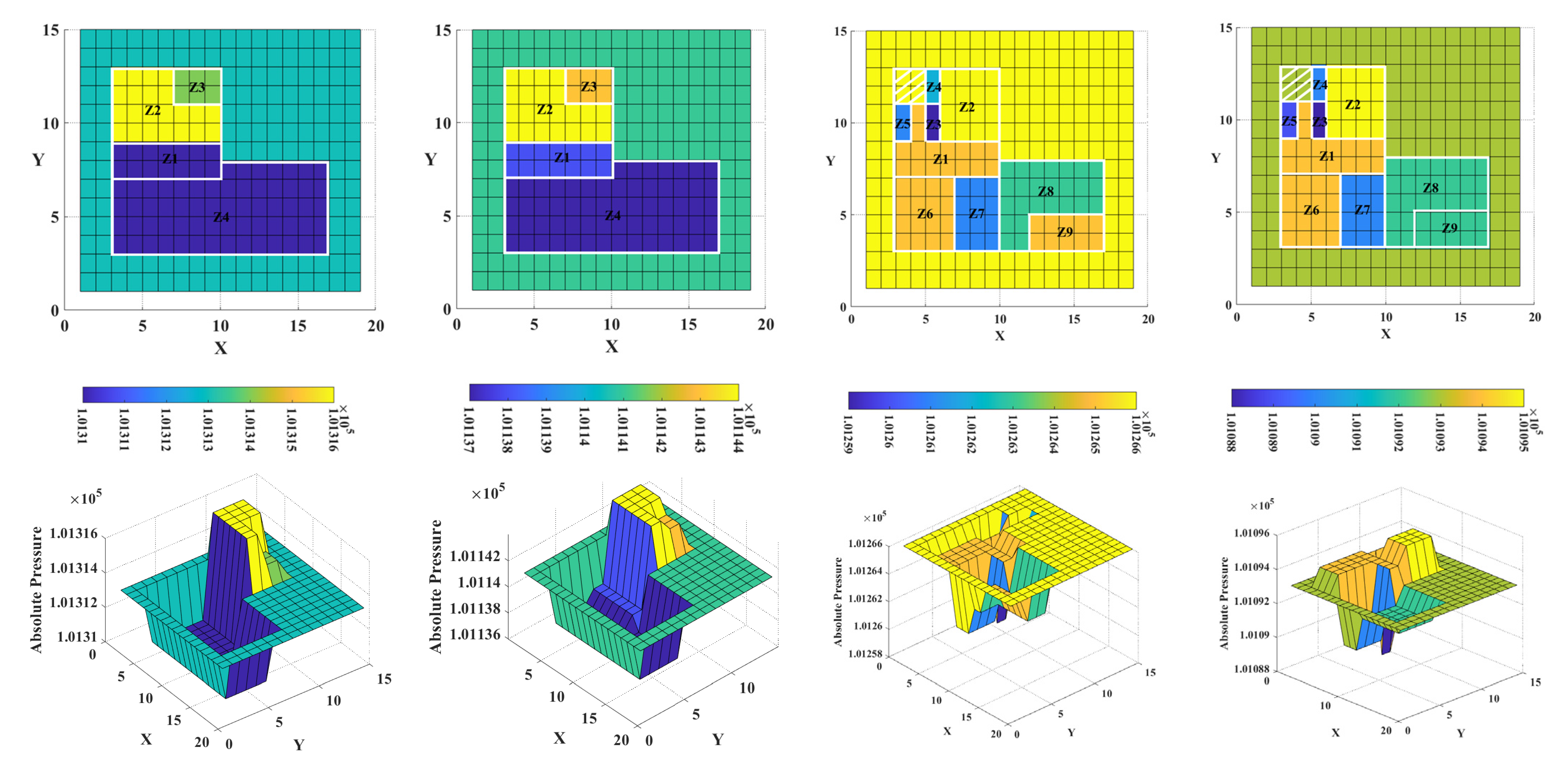
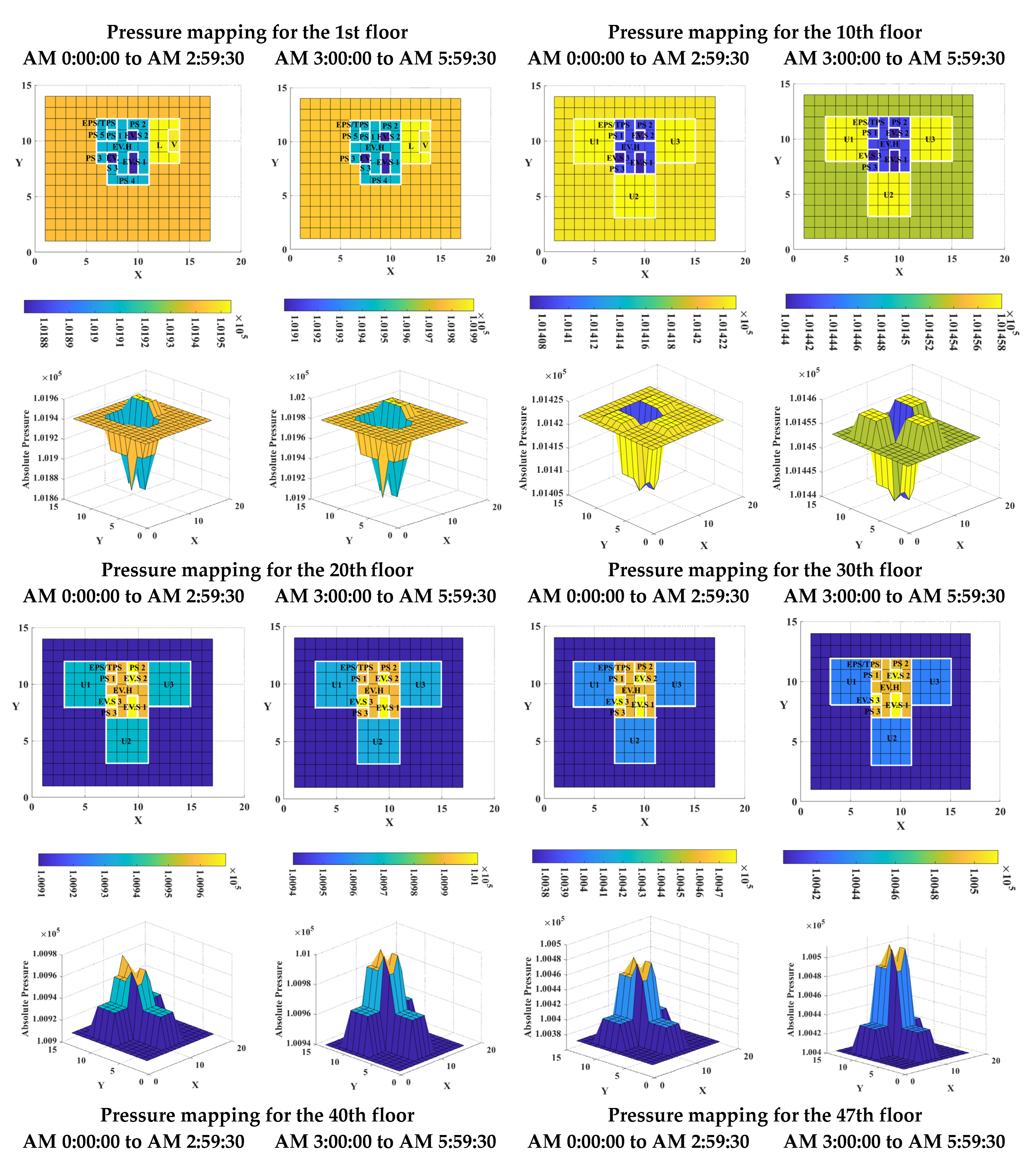

| Sensor Features | Specifications |
|---|---|
| Type | Barometer sensor: VAISALA PTB110 |
| Operating range | Range: 800 to 1100 hPa |
| Accuracy | ±0.30 hPa at 20 °C |
| Linearity | ±0.25 hPa |
| Hysteresis | ±0.03 hPa |
| Repeatability | ±0.03 hPa |
| Interval | 5 s (Minimum) |
| Storage | 8 GB |
| Specification | Building A | Building B |
|---|---|---|
| Location | Incheon, Korea | Seoul, Korea |
| Completion (year) | 2016 | 2020 |
| Dimensions (m) | 39.6 (L), 54.5 (W) | 49.35 (L), 34.6 (W) |
| Height (m) | 19.5 | 199.2 |
| Number of floors (basement) | 4 (0) | 49 (5) |
| Usage | Office, Warehouse | Residence |
| Exterior | 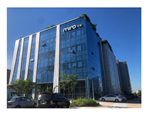 |  |
| Target Building | Zone | Coordinates Sets | |||||||||||||||
|---|---|---|---|---|---|---|---|---|---|---|---|---|---|---|---|---|---|
| Building A (4th floor) | Z6 | (3, 3), | (3, 4), | (3, 5), | (3, 6), | (4, 3), | (4, 4), | (4, 5), | (4, 6), | (5, 3), | (5, 4), | (5, 5), | (5, 6), | (6, 3), | (6, 4), | (6, 5), | (6,6) |
| Z9 | (12, 3), | (12, 4), | (13, 3), | (13, 4), | (14, 3), | (14, 4), | (15, 3) | (15, 4), | (16, 3), | (16, 4), | |||||||
| Building B (Typical floor) | H2 | (7, 3), | (7, 4), | (7, 5), | (7, 6), | (8, 3), | (8, 4), | (8, 5), | (8, 6), | (9, 3), | (9, 4), | (9, 5), | (9, 6), | (10, 3), | (10, 4), | (10, 5), | (10, 6) |
| EV.S 2 | (9, 10) | ||||||||||||||||
| Mean Pressure (Pa)-AM 0:00:00—AM 11:59:30 | Mean Pressure (Pa)-PM 12:00:00—PM 23:59:30 | ||||||||||
| Building A | Floor | Z1(Out) | Z2(Z6) | Z3 (Z7) | Z4(Z8) | Z5(Z9) | Z1(Out) | Z2(Z6) | Z3 (Z7) | Z4(Z8) | Z5(Z9) |
| 1F | 101,431 | 101,427 | 101,425 | 101,429 | — | 101,258 | 101,254 | 101,252 | 101,256 | — | |
| 101,430 | — | — | — | — | 101,258 | — | — | — | — | ||
| 2F | 101,356 | 101,360 | 101,358 | 101,359 | 101,355 | 101,184 | 101,189 | 101,186 | 101,187 | 101,183 | |
| 101,360 | — | — | — | — | 101,188 | — | — | — | — | ||
| 3F | 101,310 | 101,316 | 101,314 | 101,310 | — | 101,138 | 101,144 | 101,143 | 101,137 | — | |
| 101,313 | — | — | — | — | 101,141 | — | — | — | — | ||
| 4F | 101,265 | 101,266 | 101,259 | 101,262 | 101,261 | 101,094 | 101,095 | 101,088 | 101,090 | 101,089 | |
| 101,266 | 101,265 | 101,261 | 101,263 | 101,265 | 101,093 | 101,094 | 101,090 | 101,092 | 101,092 | ||
| Mean pressure (Pa)-AM 0:00:00—AM 2:59:30 | Mean pressure (Pa)-AM 3:00:00—AM 5:59:30 | ||||||||||
| Building B | Floor | EV.S | EV.H | L/U2 | V | Out | EV.S | EV.H | L/U2 | V | Out |
| 1F | 101,872 | 101,908 | 101,954 | 101,951 | 101,941 | 101,905 | 101,944 | 101,990 | 101,986 | 101,979 | |
| 10F | 101,407 | 101,409 | 101,423 | — | 101,422 | 101,440 | 101,442 | 101,458 | — | 101,453 | |
| 20F | 100,968 | 100,957 | 100,936 | — | 100,909 | 101,001 | 100,990 | 100,965 | — | 100,940 | |
| 30F | 100,479 | 100,458 | 100,406 | — | 100,373 | 100,512 | 100,490 | 100,432 | — | 100,403 | |
| 40F | 100,040 | 100,023 | 99,942 | — | 99,898 | 100,432 | 100,054 | 99,964 | — | 99,923 | |
| 47F | 99,731 | 99,717 | 99,599 | — | 99,559 | 99,763 | 99,748 | 99,616 | — | 99,579 | |
| Target Building | Zone | Coordinates Sets | |||||
|---|---|---|---|---|---|---|---|
| Building A (4th floor) | Z6 | (3, 3, 101, 265), | (3, 4, 101, 265), | (3, 5, 101, 265), | (3, 6, 101, 265), | (4, 3, 101, 265), | (4, 4, 101, 265), |
| (4,5,101,265), | (4,6,101,265), | (5,3,101,265), | (5,4,101,265), | (5,5,101,265), | (5,6,101,265), | ||
| (6, 3, 101, 265), | (6, 4, 101, 265), | (6, 5, 101, 265), | (6, 6, 101, 265) | ||||
| Z9 | (12, 3, 101, 265), | (12, 4, 101, 265), | (13, 3, 101, 265), | (13, 4, 101, 265), | (14, 3, 101, 265), | (14, 4, 101, 265), | |
| (15, 3, 101, 265), | (15, 4, 101, 265), | (16, 3, 101, 265), | (16, 4, 101, 265) | ||||
| Building B (20th floor) | U2 | (7, 3, 100, 936), | (7, 4, 100, 936), | (7, 5, 100, 936), | (7, 6, 100, 936), | (8, 3, 100, 936), | (8, 4, 100, 936), |
| (8, 5, 100, 936), | (8, 6, 100, 936), | (9, 3, 100, 936), | (9, 4, 100, 936), | (9, 5, 100, 936), | (9, 6, 100, 936), | ||
| (10, 3, 100, 936), | (10, 4, 100, 936), | (10, 5, 100, 936), | (10, 6, 100, 936), | ||||
| EV.S 2 | (9,10,100,968) | ||||||
Disclaimer/Publisher’s Note: The statements, opinions and data contained in all publications are solely those of the individual author(s) and contributor(s) and not of MDPI and/or the editor(s). MDPI and/or the editor(s) disclaim responsibility for any injury to people or property resulting from any ideas, methods, instructions or products referred to in the content. |
© 2023 by the authors. Licensee MDPI, Basel, Switzerland. This article is an open access article distributed under the terms and conditions of the Creative Commons Attribution (CC BY) license (https://creativecommons.org/licenses/by/4.0/).
Share and Cite
Jing, J.; Lee, D.-S.; Joe, J.; Kim, E.-J.; Cho, Y.-H.; Jo, J.-H. A Sensing-Based Visualization Method for Representing Pressure Distribution in a Multi-Zone Building by Floor. Sensors 2023, 23, 4116. https://doi.org/10.3390/s23084116
Jing J, Lee D-S, Joe J, Kim E-J, Cho Y-H, Jo J-H. A Sensing-Based Visualization Method for Representing Pressure Distribution in a Multi-Zone Building by Floor. Sensors. 2023; 23(8):4116. https://doi.org/10.3390/s23084116
Chicago/Turabian StyleJing, Jiajun, Dong-Seok Lee, Jaewan Joe, Eui-Jong Kim, Young-Hum Cho, and Jae-Hun Jo. 2023. "A Sensing-Based Visualization Method for Representing Pressure Distribution in a Multi-Zone Building by Floor" Sensors 23, no. 8: 4116. https://doi.org/10.3390/s23084116





